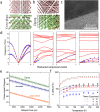Advancing Thermal Management Technology for Power Semiconductors through Materials and Interface Engineering
- PMID: 40432981
- PMCID: PMC12105000
- DOI: 10.1021/accountsmr.4c00349
Advancing Thermal Management Technology for Power Semiconductors through Materials and Interface Engineering
Abstract
Power semiconductors and chips are essential in modern electronics, driving applications from personal devices and data centers to energy technologies, vehicles, and Internet infrastructure. However, efficient heat dissipation remains a critical challenge, directly affecting their performance, reliability, and lifespan. High-power electronics based on wide- and ultrawide-bandgap semiconductors can exhibit power densities exceeding 10 kW/cm2, hundreds of times higher than digital electronics, posing significant thermal management challenges. Addressing this issue requires advanced materials and interface engineering, alongside a comprehensive understanding of materials physics, chemistry, transport dynamics, and various electronic, thermal, and mechanical properties. Despite progress in thermal management solutions, the complex interplay of phonons, electrons, and their interactions with material lattices, defects, boundaries, and interfaces presents persistent challenges. This Account highlights key advancements in thermal management for power semiconductors and chips, with a focus on our group's recent contributions. Our approach addresses several critical issues: (1) developing materials with ultrahigh thermal conductivity for enhanced heat dissipation, (2) reducing thermal boundary resistance between power semiconductors and emerging 2D materials, (3) improving thermal and mechanical contacts between chips and heat sinks, (4) innovating dynamic thermal management solutions, and (5) exploring novel principles of thermal transport and design for future technologies. Our research philosophy integrates multiscale theoretical predictions with experimental validation to achieve a paradigm shift in thermal management. By leveraging first-principles calculations, the recent studies redefined traditional criteria for high-thermal-conductivity materials. Guided by these insights, we developed boron arsenide and boron phosphide, which exhibit record-high thermal conductivities of up to 1300 W/mK. Through phonon band structure engineering, we reduced TBR in GaN/BAs interfaces by over 8-fold compared to GaN/diamond interfaces. The combination of low TBR and high thermal conductivity significantly reduced hotspot temperatures, setting new benchmarks in thermal design for power electronics. We further explored the anisotropic TBR properties of two-dimensional materials and Moiré patterns in twisted graphene, expanding the thermal design landscape. To address challenges at device-heat sink interfaces, we developed self-assembled boron arsenide composites with a thermal conductivity of 21 W/mK and exceptional mechanical compliance (∼100 kPa). These composites provide promising solutions for thermal management in flexible electronics and soft robotics. In dynamic thermal management, we pioneered the concept of solid-state thermal transistors, enabling electrically controlled heat flow with unparalleled tunability, speed, reliability, and compatibility with integrated circuit fabrication. These innovations not only enhance thermal performance but also enable the exploration of novel transport physics, improving our fundamental understanding of thermal energy transport under extreme conditions. Looking forward, we reflect on remaining challenges and identify opportunities for further advancements. These include scaling up the production of high-performance materials, integrating thermal solutions with existing manufacturing processes, and uncovering new physics to inspire next-generation power electronics technologies. By addressing these challenges, we aim to inspire future codesign strategies that enable the development of more efficient, reliable, sustainable, and high-performance electronic systems.
© 2025 The Authors. Co-published by ShanghaiTech University and American Chemical Society.
Figures












Similar articles
-
Flexible thermal interface based on self-assembled boron arsenide for high-performance thermal management.Nat Commun. 2021 Feb 24;12(1):1284. doi: 10.1038/s41467-021-21531-7. Nat Commun. 2021. PMID: 33627644 Free PMC article.
-
Thermal Properties and Phonon Spectral Characterization of Synthetic Boron Phosphide for High Thermal Conductivity Applications.Nano Lett. 2017 Dec 13;17(12):7507-7514. doi: 10.1021/acs.nanolett.7b03437. Epub 2017 Nov 13. Nano Lett. 2017. PMID: 29115845
-
Effects of Thermal Boundary Resistance on Thermal Management of Gallium-Nitride-Based Semiconductor Devices: A Review.Micromachines (Basel). 2023 Nov 8;14(11):2076. doi: 10.3390/mi14112076. Micromachines (Basel). 2023. PMID: 38004933 Free PMC article. Review.
-
Advancing high thermal conductivity: novel theories, innovative materials, and applications in thermal management technologies.J Phys Condens Matter. 2024 Aug 28;36(46). doi: 10.1088/1361-648X/ad7086. J Phys Condens Matter. 2024. PMID: 39151465 Review.
-
Power Electronics Revolutionized: A Comprehensive Analysis of Emerging Wide and Ultrawide Bandgap Devices.Micromachines (Basel). 2023 Oct 31;14(11):2045. doi: 10.3390/mi14112045. Micromachines (Basel). 2023. PMID: 38004900 Free PMC article. Review.
References
-
- Cui Y., Li M., Hu Y.. Emerging Interface Materials for Electronics Thermal Management: Experiments, Modeling, and New Opportunities. J. Mater. Chem. C. 2020;8:10568. doi: 10.1039/C9TC05415D. - DOI
-
- Ravi, S. International technology roadmap for semiconductors (ITRS), 2015. ed.; Semiconductor Industry Association, 2015. https://www.semiconductors.org/resources/2015-international-technology-r....
-
- Kang J. S., Li M., Wu H., Nguyen H., Aoki T., Hu Y.. Integration of Boron Arsenide Cooling Substrates into Gallium Nitride Devices. Nat. Electron. 2021;4:416–423. doi: 10.1038/s41928-021-00595-9. - DOI
LinkOut - more resources
Full Text Sources
